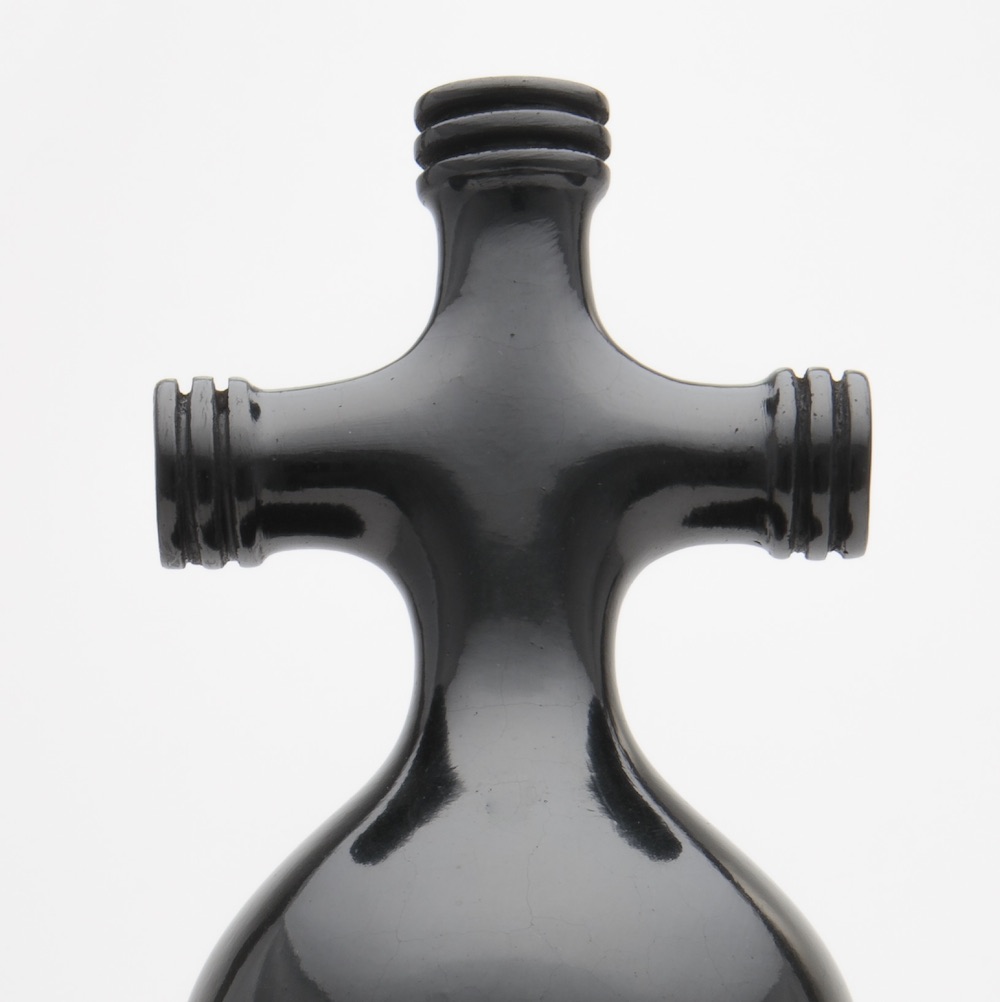SANTA FE — Ai Weiwei’s concept behind his alterations and destruction of ancient urns is that they are the junk vessels of another time. Today they would be similar to beer cans or fast food bags blowing around on the highway. Albuquerque ceramist Jami Porter Lara, by comparison, uses an ancient ceramic technique to explore the detritus of today.

Jami Porter Lara, LDS-MHB-3SBR-0916CE-01, 2016, pit-fired clay, 17 x 8 x 8 inches. Click to see a larger image. All sculpture photographs by Addison Doty, courtesy of the National Museum of Women in the Arts.

Jami Porter Lara, LDS-MHB-6SBR-0916CE-01, 2016; pit-fired clay, 10 x 6 1/2 x 6 1/2 inches. Click to see a larger image.
Her Mata Ortiz-school of pottery pays homage to the plastic bottle, following an epiphany the artist had traveling along the U.S./Mexico border. Her work is currently showing at the New Mexico Art Museum as part of Alcoves 16/17 (Albuquerque, December 9, 2016 through January 29, 2017) and she’s also showing in Peter’s Projects in Santa Fe, in an exhibition curated by Mark Del Vecchio for Peters Project (Santa Fe, 2017). You can contact Peters Project for more information about her work. Finally, she has an upcoming exhibition in Washington D.C. at the National Museum of Women in the Arts: Border Crossing (February 17 – May 14, 2017).
Mark states of her work:
Taught by Mata Ortiz potters Graciela and Hector Gallegos, Jami makes vessels the way they have been made in the desert southwest for over two thousand years. She digs clay from a site south of Albuquerque, then soaks, strains, and dries it. Vessels are hand-coiled, burnished with a smooth stone, and fired in a scrap-wood bonfire in her front yard.
Jami describes the project as a kind of reverse archaeology: digging into the present and future using tools of the past.

(Left)Jami Porter Lara, JMS-MHB-2LBR-0913CE-03, 2013; pit-fired clay, 11 x 4 x 4 inches. (Right) Jami Porter Lara, LDS-MHB-2LBR-0515CE-05, 2015; pit-fired clay, 12 x 4.25 x 4.25 inches.

(Left) Jami Porter Lara, LDS-MHB-CVBR-0916CE-03 , 2016; pit-fired clay, 15 x 5.5 x 5.5 inches. (Right) Jami Porter Lara, LDS-MHB-FFBR-0615CE-02, 2015; pit-fired clay, 10.75 x 3.75 x 3.75 inches.
Jami Porter Lara uses a 2000-year-old process to make objects that resemble a ubiquitous icon of modern life—the plastic bottle, the artist states. While exploring a remote stretch of the U.S./Mexico border, Porter Lara found two-liter bottles used to carry water—the most recent in a lineage of artifacts that remain from millennia of human travel through the region. Using these found objects as source, her purpose is to reconceptualize the plastic bottle to better represent its function as a precious object—a vessel—capable of sustaining human life. And within that purpose, her hope is to illuminate the necessity that feeds ubiquity; to expose the porous nature of “borders” as well as the “nature” of art and pollution; to record her interest in the permeability of all things human, natural, and technological. By pulling the plastic bottle away from the profane and towards what we perceive to be beautiful or natural or sacred, she hopes that human beings can find some forgiveness for ourselves and the things that we make, and seeks to provide a space to contemplate both an ethical beauty as well as an ethics of beauty in the face of human need.

Jami Porter Lara, Go On Now (detail), 2016; pit-fired clay, 167 sculptures, 167 sculptures, 3-6 x 2 1/2 – 3 1/2 in diameter. Click to see a larger image. Sculpture photographs by Addison Doty.
Born in 1969 in Spokane, Washington, Jami has lived in Albuquerque, New Mexico since 1980. Rejecting the notion that humanity is the opponent of nature, Jami is a conceptual artist whose approach to making remains deeply tied to her concern with cultural inheritances and with being a citizen of the the natural world. Her work is widely collected and has been featured in American Art Collector Magazine, Hyperallergic, and on PBS stations nationwide. Recent exhibitions include the New Mexico Museum of Art; the Center for Land Use Interpretation in Wendover, Utah; the Museum of Contemporary Art in Los Angeles. She is represented by Central Features Contemporary Art in Albuquerque, Peters Projects in Santa Fe, and Stephanie Breitbard Fine Arts in San Francisco.
For inquiries, please contact Mark Del Vecchio, Program Director of Ceramics & Design, mark@petersprojects.com, (505)-954-5800.
Do you love or loathe these works of contemporary ceramic art? Let us know in the comments.





Love. For if we cannot understand ourselves to be part of the natural world, that this is our place of belonging, we will fail to see it as our own body that we defile when we pollute.
Thank you for mentioning the Alcove exhibition at the New Mexico Museum of Art. The entire series runs March 5, 2016 – March 26, 2017 – but the exhibition Jami Porter Lara’s work is in runs through January 29, 2017 – with an in gallery conversation with the artists on January 6 5:30 PM.
Jami’s work, her story and her conceptualization of her art are astounding! Not only is she an exceptional ceramicist but the thinking that goes into her decision to create her objects has great fascination for me. She is an artist on the move and I expect that her international renown will be actualized soon. As a collector, I have several of her pieces and will continue to support her work in this area.